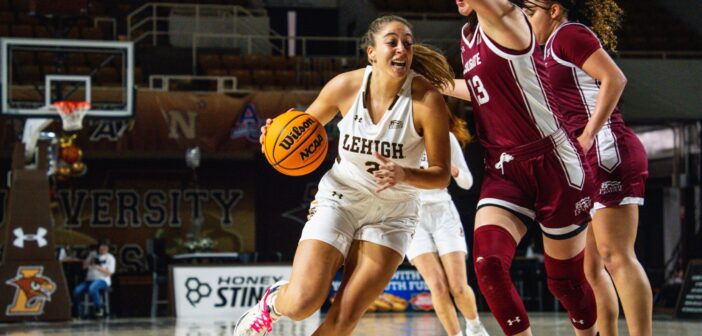Editor’s Note: This headline has been updated for clarity purposes.
In 2023, more than 15,000 student athletes made the decision to enter the NCAA transfer portal and enroll in new institutions to grow academically and athletically.
When the NCAA first launched the transfer portal in 2018, it provided student athletes with the chance to reshape their college experience, whether by finding a better team culture, gaining more playing time, or pursuing new academic and athletic opportunities.
While the portal often granted student athletes more control of their future, it has also complicated the recruiting process and presented new challenges for college coaches, who have had to adapt to an evolving landscape to attract new student athletes to their program.
In college athletics, each school, sport and team handles recruiting differently, and even more so as the process evolves and becomes more complex. At Lehigh, coaches and players have a range of perspectives on how rosters, strategies and team dynamics affect and are affected by recruiting.
Lehigh women’s basketball
Addie Micir, Lehigh’s women’s basketball coach, said she uses several approaches to recruit players. Some players are recommended to her, and she has followed others over the years at Amateur Athlete Union tournaments.
However, no matter how she discovers a player, she said character and coachability stand firm at the top of her checklist.
As she evaluates potential recruits, Micir said, speaking with previous coaches and family members helps her determine whether an athlete will be a good fit.
“It takes a village to be really, really good,” she said.
Senior guard Remi Sisselman experienced Micir’s recruiting strategy firsthand.
Sisselman started her college recruitment process early in high school, earning 35 offers by the end of her sophomore year. Reflecting on the process, she said many coaches and players contacted her to highlight the strengths of their schools and programs.
“It’s a lot of rainbows and butterflies,” Sisselman said. “If a coach wants you, they’re going to do pretty much everything … It just makes you think that you are so loved, and of course, sometimes it really is like that, but sometimes it’s not.”
At the end of her junior year of high school, Sisselman committed to Bucknell University. She said going to a small liberal arts school like Bucknell felt like the right decision and led her to believe her talents would be valued.
However, by the end of her sophomore year at Bucknell, she sought a fresh start and new opportunities. She then entered the transfer portal.
As she restarted her college search, Sisselman knew she wanted to stay in the Patriot League, which led her to consider Lehigh. After speaking with the Lehigh coaches, Sisselman said she felt she knew everything inside and out.
“I asked a million questions, because I went in so blind as a high school kid,” she said. “I didn’t want to make any mistakes, so I went through everything differently.”
Taking many of the coaches’ words “with a grain of salt,” Sisselman also spoke to the team members to better understand what her day-to-day life would be like. She also said it was essential for her to understand a coach’s character.
In addition to wanting to be a part of a strong basketball program, Sisselman sought a coach who would take basketball seriously and value relationships. She said she wanted to understand how a coach reacted to winning or losing a game, and whether they treated starters and non-starters differently.
Taking these details into account, she said her deep dive answered all her questions and eased her fears, leading her to decide on Lehigh.
In the age of social media, many coaches have found new avenues to showcase their teams offerings.
At Lehigh in particular, Micir said she has found the team’s social media channels have been the easiest way for people to learn more. The women’s basketball team consistently uses its official pages to release content that highlights their program and values.
Micir highlighted the importance of getting players with good energy who are excited to buy into their “share it and shoot it” mantra — an offensive scheme that involves shooting three-pointers and frequent ball movement, which has been key to the team’s identity and shared on its social media.
Micir said she ensures all recruits understand this philosophy before having more in-depth conversations regarding their role on the team, and she takes note of a player’s attitude toward the mantra.
Micir said the team gets a lot of interest from social media, and many recruits say they already know about the team from looking online. When Micir taps into the transfer portal, her tactics are no different.
When recruiting transfer athletes, Micir said it’s easiest when the player knows what they want for the remainder of their college career and she understands their reason for transferring.
She also said she aims to be as transparent as possible with prospective student athletes. When she speaks to them, she said she’s clear about how the player could impact the team.
Lehigh football
Like Sisselman, senior offensive lineman Christian Curatolo, also navigated the transfer portal after his first year of college. However, Curatolo was looking to leave Lehigh.
Coming off a strong season, during which Curatolo played eight out of 11 games, many disagreements with the then-coach Tom Gilmore led him to look elsewhere for his sophomore year. Curatolo ended up at Boston College.
He said he was excited to play for Dave DeGuglielmo, a former offensive lineman coach for the New York Giants during their 2007 Super Bowl win. However, after a losing season, Boston replaced DeGuglielmo with Rob Chudzinski.
“At Boston College, the coaches were not as personable,” Curatolo said. “If you can deliver on the field, they love you, but if you don’t, that’s a whole nother story.”
Feeling like he no longer fit into coach Chudzinski’s puzzle, Cuatolo said he decided to give the transfer portal another look.
When Kevin Cahill was named Lehigh’s head coach, it caught Curatolo’s attention, and he reconsidered his original school. Curatolo said he loved playing with his Lehigh teammates before, so he decided to give it another shot.
“It was the best decision I ever made,” he said.
Curatolo returned to Lehigh for the 2023 season. Throughout the season, he said he felt there was a standard he needed to uphold. By mid-season, both he and his coaches realized he wasn’t meeting that standard.
Through a transparent and supportive relationship with his coaches, he was able to turn things around and fully reintegrate into the team. By his senior year, he built stronger relationships with his teammates and regained his passion for the sport.
“They made me fall in love with this place again,” Curatolo said.
He also credited Cahill’s coaching style with making his return smooth, calling him the “father of their team.”
“If you have any issues, (Cahill) makes it clear (when he says), ‘Please don’t be afraid to come talk to me anytime that you need anything,’” Curatalo said. “That’s something that you don’t always get at at the other levels.”
Lehigh men’s basketball
Men’s basketball coach Brett Reed said the most important qualities he looks for when recruiting student athletes are a desire for an elite education and a drive in basketball. He said Lehigh is a place where a potential Mountain Hawk will not have to sacrifice a great education for a great basketball program.
“The more things have changed, the more we’ve had to really look at the root of our recruiting message,” Reed said.
For his program, he said having players with good character is a critical attribute that won’t go unnoticed.
Through conversations with a player’s previous coach and family members, Reed said the coaches evaluate whether a player will fit within their mission statement. The coaching staff also observes how players interact with their teammates and handles adversity.
Reed’s program has traditionally focused on player development. He said he prefers to recruit high school players and nurture their growth over the years.
The development journey starts immediately during the summer sessions before their first years at Lehigh, he said. There, incoming first-years get accustomed to the college game and workout intensity.
Unlike other programs, Reed said delving into the transfer portal is not his top priority. Instead, he said, retention is critical to the team.
“Since COVID, I don’t think we’ve had anybody who has left our program that hasn’t graduated from Lehigh,” Reed said.
By investing in his players over the course of their college career and providing guidance from his coaching staff, Reed said his players grow into leadership roles and take on more responsibilities within the program.
To reinforce their mission statement and facilitate understanding within recruits, Reed created a six-video series that details his coaching philosophy, playing strategies, the key characteristics he looks for in recruits and program culture.
He said these videos allow recruits to visualize themselves in the program, especially those who may not be able to visit campus in person.
At its core, the foundation of a successful college athletics experience goes far beyond the x’s and o’s on a whiteboard. Many student athletes are looking for a place where they belong and can develop academically and athletically.
“It’s not about the colors,” Sisselman said. “It’s not about the court or the field you play on. I think it’s the people in the environment that you’re surrounded by.”






Comment policy
Comments posted to The Brown and White website are reviewed by a moderator before being approved. Incendiary speech or harassing language, including comments targeted at individuals, may be deemed unacceptable and not published. Spam and other soliciting will also be declined.
The Brown and White also reserves the right to not publish entirely anonymous comments.
1 Comment
This article avoids the NIL issue of compensation for athletes. It would appear that is not a factor yet for Lehigh Football or basketball coaches or presumably it would have come out in the article?